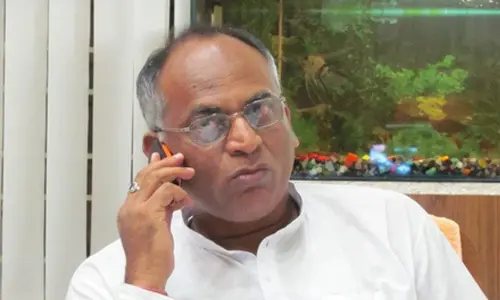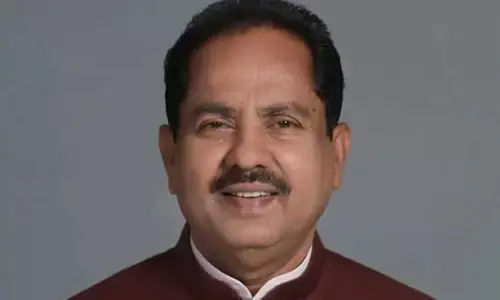Power cos going belly up

Large numbers of thermal and hydroelectric power generation companies are facing bankruptcy The main reason is that the demand for electricity is not growing as expected despite a booming Sensex
Large numbers of thermal and hydroelectric power generation companies are facing bankruptcy. The main reason is that the demand for electricity is not growing as expected despite a booming Sensex.
This riddle becomes clear when we consider the relative movements of the Sensex and the GDP growth rate. The Sensex has crossed 37,000 recently, which is much higher than the 30,000 mark scaled during the UPA government. At the same time, the GDP growth rate is presently placid at about 7 per cent, which is lower than the 8-9 per cent attained during the UPA government. The Sensex is up and growth is down during the NDA government.
This contrary movement indicates that the big companies that drive the Sensex are doing well, while the larger economy that drives the GDP is placid. Demonetisation, the complicated compliance system of GST, and the fear phobia of scrutiny by the income tax authorities has killed large numbers of small businesses such as those making biscuits and bread in small towns.
The market of the closed small businesses has been captured by the Sensex companies. This shift in the market means that there is little overall growth; but the Sensex companies are doing well. This explains the booming Sensex with low GDP growth.
The profits made by the Sensex companies are distributed to investors who are, generally speaking, “rich.” These people already have washing machines and air-conditioners installed in their houses.
The additional income received by them does not, therefore, translate into much increase in demand of electricity. On the other hand, the owners and workers of the small businesses have a desire to buy the same washing machines and air-conditioners.
But the decline in their incomes has prevented them from buying these equipment and led to a stagnation in the demand for electricity. Thus the overall demand of electricity is declining.
Another reason for less demand of electricity is that the global economy is moving from manufacturing to services. The services sector includes call centers, movie studios, tourist hotels and the like. One rupee of GDP produced in the manufacturing sector requires ten times the electricity than the same one rupee of GDP produced in the services sector. The shift to services is leading to less growth in electricity consumption.
The combined effect of killing of small businesses and shift to services is that the electricity consumption is not growing. It grew at 5.9 per cent in April-May 2017. This growth declined to 3.1 per cent in April-May 2018.
This low growth in electricity consumption has led to the spot price of electricity remaining flat. According to data from the India Energy Exchange, the average price of electricity in 2017-18 was Rs 3.26 per unit. The thermal projects are viable at a price of Rs 5 to 6 per unit. Thus, they are no longer profitable and are going bankrupt.
The cost of generation of electricity by thermal and hydro power plants is also high because of “padding” by the owners. Say, the project cost is Rs 100 crore. The banks require the promoter to invest 25 per cent of the project cost. So, the promoter increases the project cost to Rs 200 crores.
The banks give 75 per cent of this cost, that is, Rs 150 crore as a loan. The promoter spends Rs 200 crore in the account books. He spends Rs 100 crore to put up the plant; and puts in vouchers for fictitious purchases of Rs 100 crore and pays this money to his own shell companies. He siphons off Rs 50 crore during the construction of the project itself.
In the process the total project cost is increased and the cost of electricity produced is increased proportionally. The Srinagar Hydroelectric Project was approved by the Central Electricity Authority of the Ministry of Power at a cost of Rs 1,800 crore. At the last reckoning, the promoters had hiked the cost to Rs 5,300 crore. Thus the cost of electricity produced by the thermal and hydro projects becomes high.
Needless to say, this siphoning of the funds takes place with the active connivance of banks. I had given a representation to the Punjab National Bank against extending additional loans to the Srinagar Hydroelectric Project. But the PNB gave the loans which have now turned bad.
The growth of solar power has not helped. The price of solar power in a recent auction in Madhya Pradesh was a meager Rs 1.58 per unit. The cost of thermal power is about Rs 5 per unit and hydropower is around Rs 8 per unit. Thus, purchasers prefer to buy power from the solar projects and not from thermal and hydro plants.
The troubles of the thermal power generation companies are, therefore, due to: (1) The killing of small businesses by demonetisation and GST; (2) Shift from manufacturing to services; (3) Padding of the project costs; and (4) Low cost of solar power. The first and the third of these are due to the misplaced policies of the NDA government. The second and the fourth are structural issues that no government can solve.
Thus, the thermal and the hydro companies will continue to go bankrupt. How did we get here? The mischief was done by the Central Electricity Authority. This statutory body has published highly inflated forecasts of electricity demand for many years now. For 2003-04, for example, the CEA had forecast a demand of 467 trillion units in the year 2000. The actual demand in 2003-04 was only 362 Trillion units.
The CEA has encouraged the establishment of large numbers of thermal and hydro power projects by making such false inflated forecasts. I along with Professors V Ranganathan and Vinod Vyasulu had given a representation to CEA in 2010 pointing out the flaws in the methodology used in making its forecasts. The response of the CEA was to stop giving details of the methodology while continuing to publish inflated forecasts.
The officers of the CEA make moolah only if new projects, especially hydro projects, are submitted for approval. In the pursuit of their moolah they have made exaggerated forecasts, and encouraged establishment of large numbers of thermal and hydro projects that are now going bankrupt.
The NDA government will do well not to bail out these projects and, in the process, throw more good money after bad. We should let these projects die and focus on the development of our services sector which requires less energy, and the solar power generation which is much cheaper and suitable for our natural resources. We do not have much coal, hydro power is killing both our environment and culture; but we have plenty of sun. Author was formerly Professor of Economics at IIM Bengaluru














